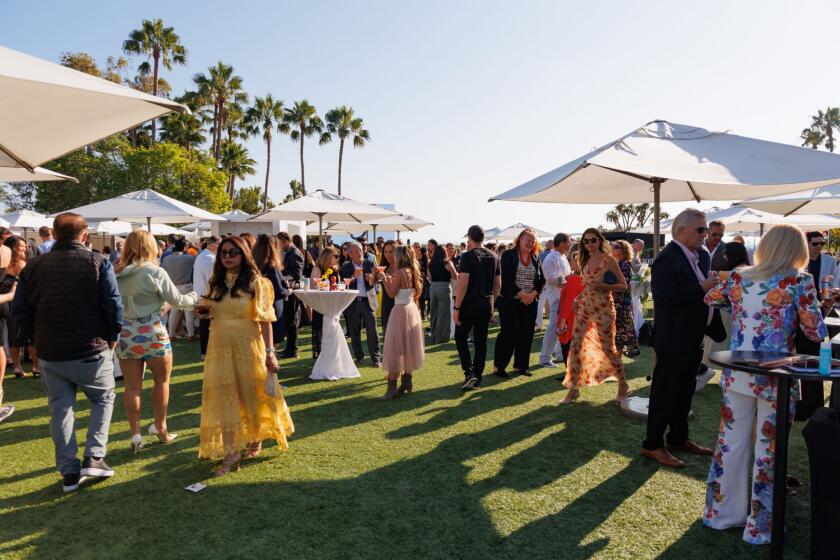We’re not in Kansas anymore, Toto
- Share via
VIC LEIPZIG AND LOU MURRAY
From the looks of many people’s landscaping here in town, you’d think
we live in the Midwest. Yards all over town sport emerald green
grassy lawns, rose bushes, jewel-toned impatiens and other
water-thirsty plants.
Well, guess what -- we don’t live in Ohio or Oregon or New
England, although many of us moved here from such places. Orange
County has grown from a sleepy rural enclave of 300,000 people in the
early 1950s to its present size, a teeming three-million people.
Obviously that’s not due solely to reproduction. That huge population
increase is due largely to people moving here from somewhere else.
When these new arrivals put down roots in their chosen land -- and
who wouldn’t choose this fabulous town to live in -- they want their
yards to look like “back home.” Where it probably rained 40 inches a
year, not the 12 to 14 inches that we normally receive here on the
coast.
Grassy lawns and rose gardens are fine for people who live in the
Midwest or Pacific Northwest, where they get enough rain to grow
dense hardwood forests or towering redwoods with a ferny understudy.
But we live in a virtual desert. We don’t have enough rain to keep
things green naturally except for a few short months each year.
Why do we persist in growing plants that don’t belong here?
Because water is so cheap. We are able to grow plants with high water
requirements because we can just turn on the spigot and get all the
water we want.
We are used to the idea that we can get all the water we need to
grow whatever we want. But should we do that? We live in Southern
California. We should have gardens that reflect a native landscape.
The local birds and insects would appreciate being able to find some
of the plants they used to feed upon. Think about it: In the past 50
years, developers have converted huge areas of natural landscape to
homes and businesses. These areas almost always get landscaped with
nonnative vegetation, plants that require two to three times more
water than what was growing there before.
There are many beautiful flowers, shrubs and trees that grow
naturally on the coast with only the water that nature gives them.
With only a little additional water supplementation, these plants can
remain lush and flowering throughout the year. If you think that
California native plants are just a collection of cactus and brown
things, think again. The flowers of coastal sages vary from deep
scarlet to lilac to electric blue. Buckwheat and narrow-leafed
milkweed bloom with big flower heads colored in delicate pinks and
whites -- and the butterflies love them. Monkeyflower comes in reds,
oranges and yellows, but fuchsia-flowering gooseberry comes only in
-- surprise -- fuchsia. The colors are great, but the highlight is
the aroma! You won’t believe how wonderfully strong and varied the
smells can be until you grow your own native plant garden.
There is a real need to shift our thinking away from water-craving
vegetation toward a more natural and environmentally friendly plant
palette. As our population has increased, our water supply has
actually decreased. The droughts that have come with global warming
have resulted in a reduction of our water supply from both the
Colorado Rockies and Sierra Nevada mountains. In order to grow lush
green foreign gardens, we have to import tremendous amounts of water
at a huge cost. That’s not just financial cost, but environmental
cost. We’re taking water that rightfully belongs in the mountain and
river ecosystems that it came from.
It doesn’t have to be like this. If more people would landscape
their yards with native plants, we could reduce water consumption
dramatically. Half of all household water use is taken by
landscaping.
Fortunately, there is an easy way to get started with a California
native plant garden. There is a plant sale coming up this Saturday in
Huntington Beach Central Park. The Friends of Shipley Nature Center
will have a display showing how beautiful these native plants can be,
and will have many varieties for purchase for a modest price. By
buying some of these plants to plant your own California native plant
garden, you will not only be saving water, you’ll be helping to
support the Friends’ efforts to restore and reopen Shipley Nature
Center.
If you would like to support the plant sale, but you don’t have
the space to dedicate to a California native garden at this time or
you’re not quite ready to rip out your roses, there is still
something you can do. You can buy a plant and have a Scout plant it
at the nature center. Or you can plant it there yourself. Or you can
plant some of the coast sunflowers, California sage, bladderpod and
other plants that the Friends will provide for planting in the area
to be restored that day. Tools are also provided.
The plant sale will be from 9 a.m. to 3 p.m., unless all the
plants are sold first. The restoration workday at Shipley Nature
Center will go from 9 a.m. to noon, with informal seminars throughout
the morning on how to grow a native plant garden. It’s surprisingly
easy. Let’s have our gardens and yards reflect the truly beautiful
landscape of this glorious state.
* VIC LEIPZIG and LOU MURRAY are Huntington Beach residents and
environmentalists. They can be reached at vicleipzig@aol.com.
All the latest on Orange County from Orange County.
Get our free TimesOC newsletter.
You may occasionally receive promotional content from the Daily Pilot.





